Sino Iron: Overcoming Challenges in International Business
VerifiedAdded on 2023/05/28
|10
|2272
|156
Case Study
AI Summary
This case study examines Sino Iron's experiences in Australia, highlighting the challenges faced by the Chinese iron and steel company in the international market. The project, initiated in 2007, suffered significant delays and budget overruns due to internal and external factors such as fluctuating iron prices, bureaucratic hurdles, and cultural differences between Chinese and Australian counterparts. The analysis includes a TOWS matrix and PESTLE analysis to understand the internal strengths and weaknesses, as well as the external political, economic, social, technological, legal, and environmental factors affecting the company. The report suggests strategies for improving the company's image, building a strong workforce, and obtaining necessary permits. Recommendations include clarifying job roles, understanding the local market, appointing skilled individuals for aggressive planning, and appropriately managing expats. The case study emphasizes the importance of a global business manager in balancing stakeholder requirements and adapting to local customs and regulations. Desklib provides access to similar case studies and solved assignments for students.
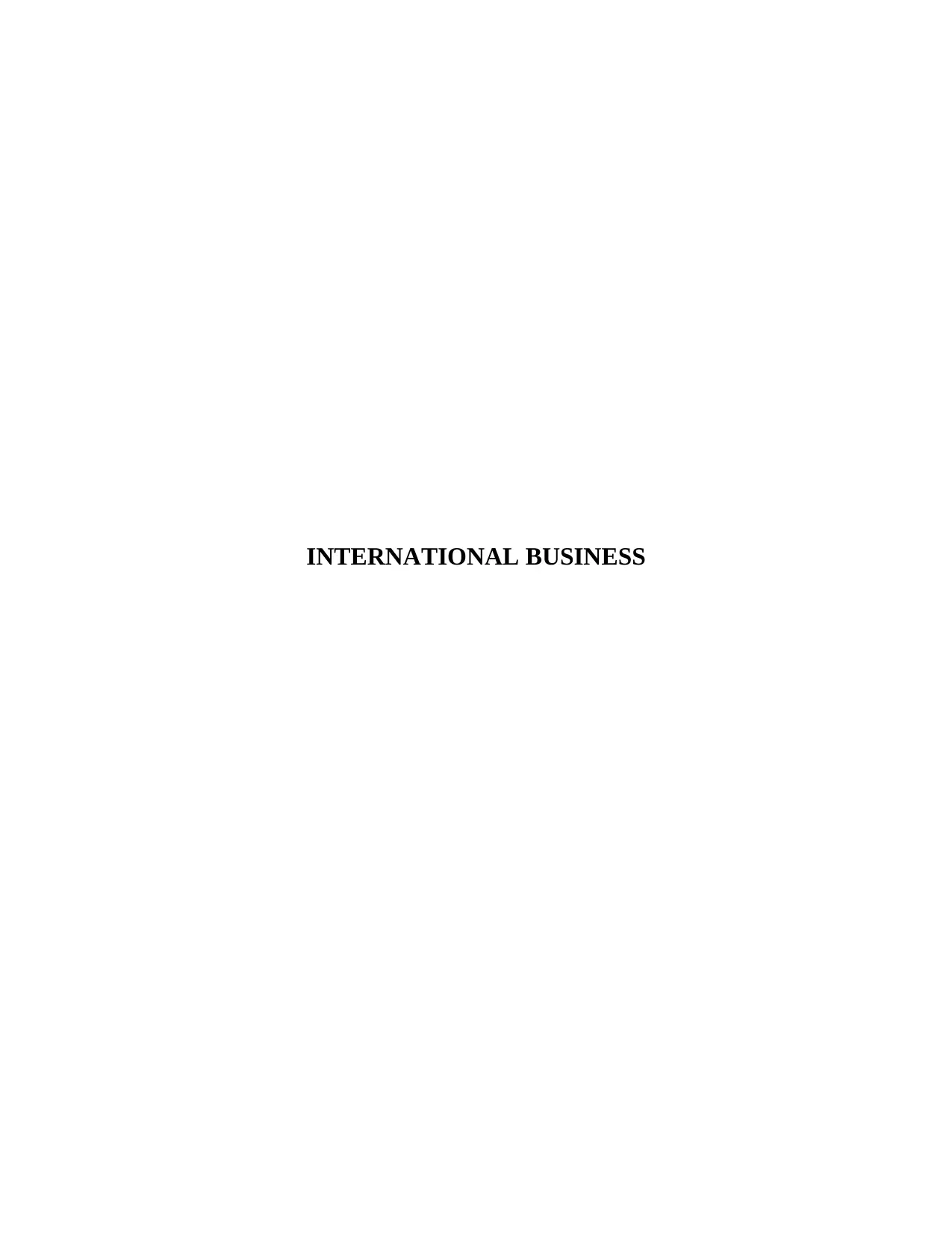
INTERNATIONAL BUSINESS
Paraphrase This Document
Need a fresh take? Get an instant paraphrase of this document with our AI Paraphraser
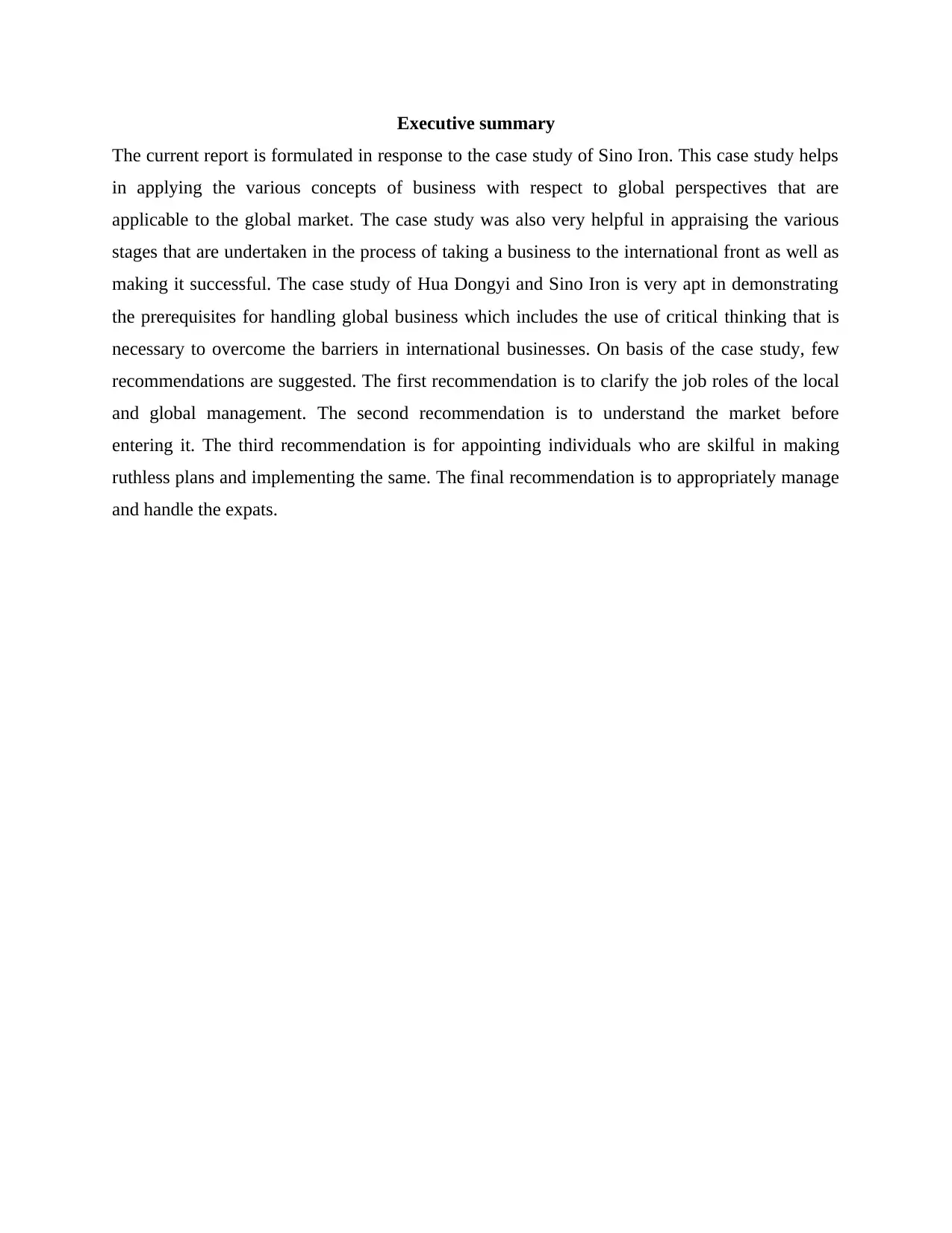
Executive summary
The current report is formulated in response to the case study of Sino Iron. This case study helps
in applying the various concepts of business with respect to global perspectives that are
applicable to the global market. The case study was also very helpful in appraising the various
stages that are undertaken in the process of taking a business to the international front as well as
making it successful. The case study of Hua Dongyi and Sino Iron is very apt in demonstrating
the prerequisites for handling global business which includes the use of critical thinking that is
necessary to overcome the barriers in international businesses. On basis of the case study, few
recommendations are suggested. The first recommendation is to clarify the job roles of the local
and global management. The second recommendation is to understand the market before
entering it. The third recommendation is for appointing individuals who are skilful in making
ruthless plans and implementing the same. The final recommendation is to appropriately manage
and handle the expats.
The current report is formulated in response to the case study of Sino Iron. This case study helps
in applying the various concepts of business with respect to global perspectives that are
applicable to the global market. The case study was also very helpful in appraising the various
stages that are undertaken in the process of taking a business to the international front as well as
making it successful. The case study of Hua Dongyi and Sino Iron is very apt in demonstrating
the prerequisites for handling global business which includes the use of critical thinking that is
necessary to overcome the barriers in international businesses. On basis of the case study, few
recommendations are suggested. The first recommendation is to clarify the job roles of the local
and global management. The second recommendation is to understand the market before
entering it. The third recommendation is for appointing individuals who are skilful in making
ruthless plans and implementing the same. The final recommendation is to appropriately manage
and handle the expats.
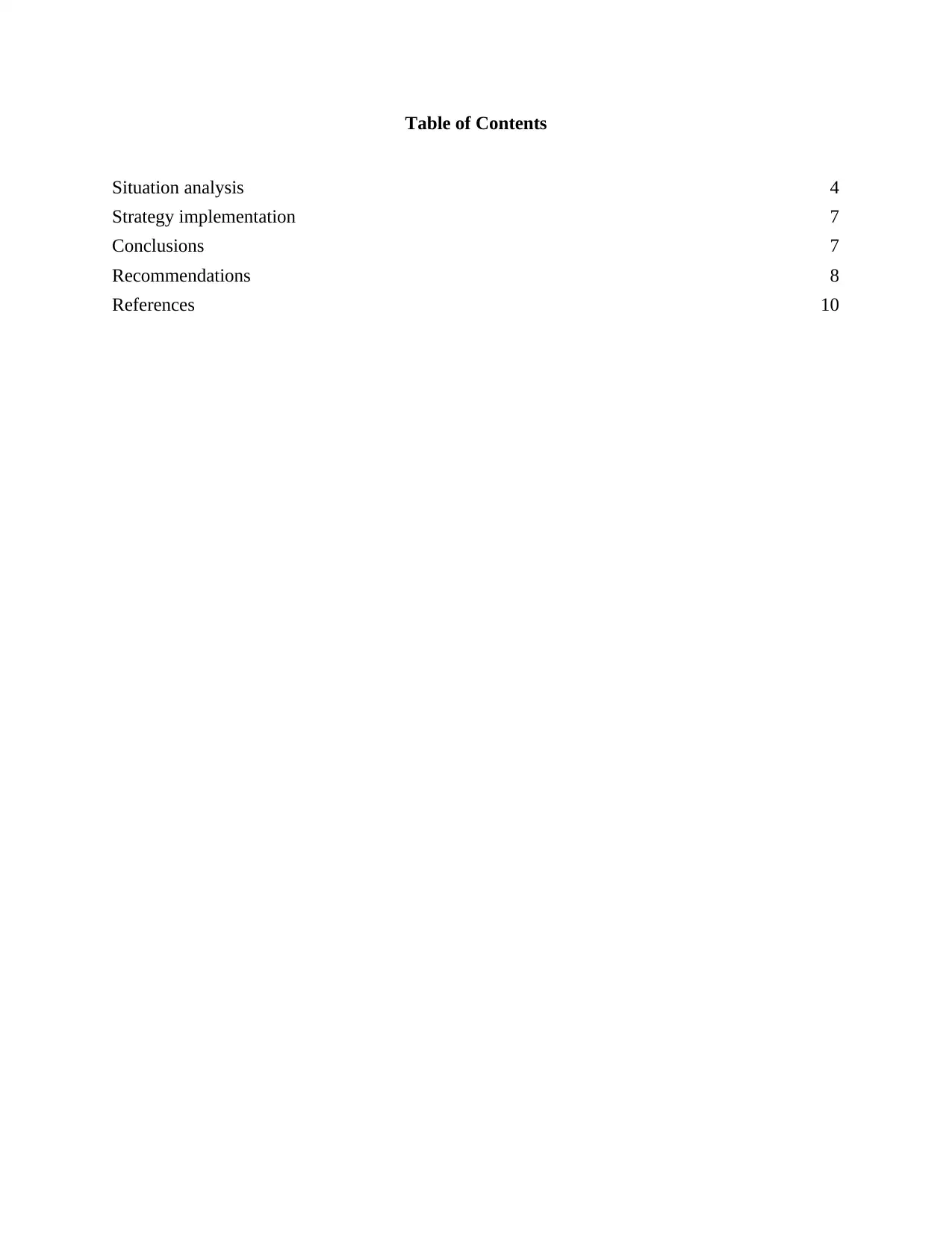
Table of Contents
Situation analysis 4
Strategy implementation 7
Conclusions 7
Recommendations 8
References 10
Situation analysis 4
Strategy implementation 7
Conclusions 7
Recommendations 8
References 10
⊘ This is a preview!⊘
Do you want full access?
Subscribe today to unlock all pages.

Trusted by 1+ million students worldwide
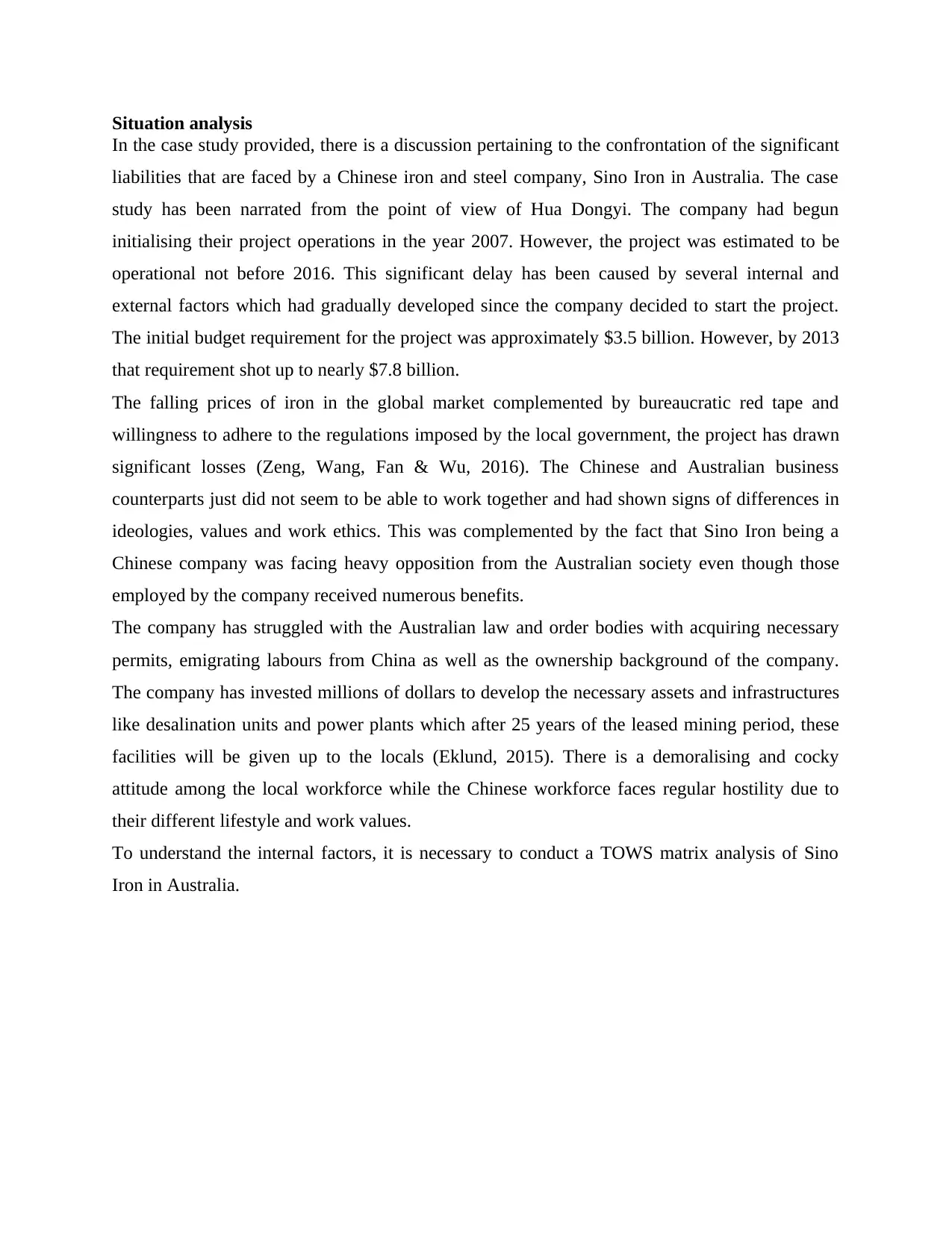
Situation analysis
In the case study provided, there is a discussion pertaining to the confrontation of the significant
liabilities that are faced by a Chinese iron and steel company, Sino Iron in Australia. The case
study has been narrated from the point of view of Hua Dongyi. The company had begun
initialising their project operations in the year 2007. However, the project was estimated to be
operational not before 2016. This significant delay has been caused by several internal and
external factors which had gradually developed since the company decided to start the project.
The initial budget requirement for the project was approximately $3.5 billion. However, by 2013
that requirement shot up to nearly $7.8 billion.
The falling prices of iron in the global market complemented by bureaucratic red tape and
willingness to adhere to the regulations imposed by the local government, the project has drawn
significant losses (Zeng, Wang, Fan & Wu, 2016). The Chinese and Australian business
counterparts just did not seem to be able to work together and had shown signs of differences in
ideologies, values and work ethics. This was complemented by the fact that Sino Iron being a
Chinese company was facing heavy opposition from the Australian society even though those
employed by the company received numerous benefits.
The company has struggled with the Australian law and order bodies with acquiring necessary
permits, emigrating labours from China as well as the ownership background of the company.
The company has invested millions of dollars to develop the necessary assets and infrastructures
like desalination units and power plants which after 25 years of the leased mining period, these
facilities will be given up to the locals (Eklund, 2015). There is a demoralising and cocky
attitude among the local workforce while the Chinese workforce faces regular hostility due to
their different lifestyle and work values.
To understand the internal factors, it is necessary to conduct a TOWS matrix analysis of Sino
Iron in Australia.
In the case study provided, there is a discussion pertaining to the confrontation of the significant
liabilities that are faced by a Chinese iron and steel company, Sino Iron in Australia. The case
study has been narrated from the point of view of Hua Dongyi. The company had begun
initialising their project operations in the year 2007. However, the project was estimated to be
operational not before 2016. This significant delay has been caused by several internal and
external factors which had gradually developed since the company decided to start the project.
The initial budget requirement for the project was approximately $3.5 billion. However, by 2013
that requirement shot up to nearly $7.8 billion.
The falling prices of iron in the global market complemented by bureaucratic red tape and
willingness to adhere to the regulations imposed by the local government, the project has drawn
significant losses (Zeng, Wang, Fan & Wu, 2016). The Chinese and Australian business
counterparts just did not seem to be able to work together and had shown signs of differences in
ideologies, values and work ethics. This was complemented by the fact that Sino Iron being a
Chinese company was facing heavy opposition from the Australian society even though those
employed by the company received numerous benefits.
The company has struggled with the Australian law and order bodies with acquiring necessary
permits, emigrating labours from China as well as the ownership background of the company.
The company has invested millions of dollars to develop the necessary assets and infrastructures
like desalination units and power plants which after 25 years of the leased mining period, these
facilities will be given up to the locals (Eklund, 2015). There is a demoralising and cocky
attitude among the local workforce while the Chinese workforce faces regular hostility due to
their different lifestyle and work values.
To understand the internal factors, it is necessary to conduct a TOWS matrix analysis of Sino
Iron in Australia.
Paraphrase This Document
Need a fresh take? Get an instant paraphrase of this document with our AI Paraphraser
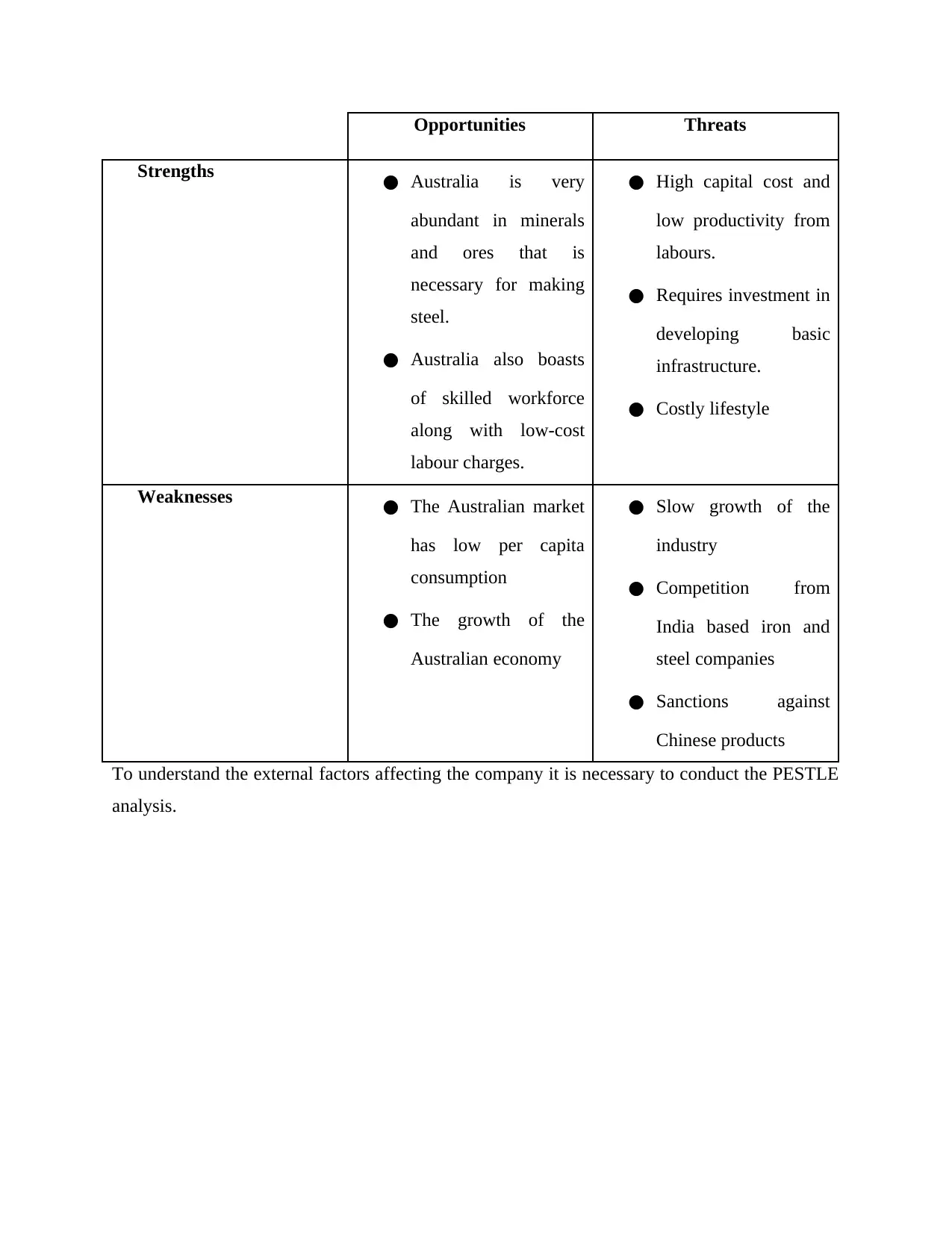
Opportunities Threats
Strengths ● Australia is very
abundant in minerals
and ores that is
necessary for making
steel.
● Australia also boasts
of skilled workforce
along with low-cost
labour charges.
● High capital cost and
low productivity from
labours.
● Requires investment in
developing basic
infrastructure.
● Costly lifestyle
Weaknesses ● The Australian market
has low per capita
consumption
● The growth of the
Australian economy
● Slow growth of the
industry
● Competition from
India based iron and
steel companies
● Sanctions against
Chinese products
To understand the external factors affecting the company it is necessary to conduct the PESTLE
analysis.
Strengths ● Australia is very
abundant in minerals
and ores that is
necessary for making
steel.
● Australia also boasts
of skilled workforce
along with low-cost
labour charges.
● High capital cost and
low productivity from
labours.
● Requires investment in
developing basic
infrastructure.
● Costly lifestyle
Weaknesses ● The Australian market
has low per capita
consumption
● The growth of the
Australian economy
● Slow growth of the
industry
● Competition from
India based iron and
steel companies
● Sanctions against
Chinese products
To understand the external factors affecting the company it is necessary to conduct the PESTLE
analysis.
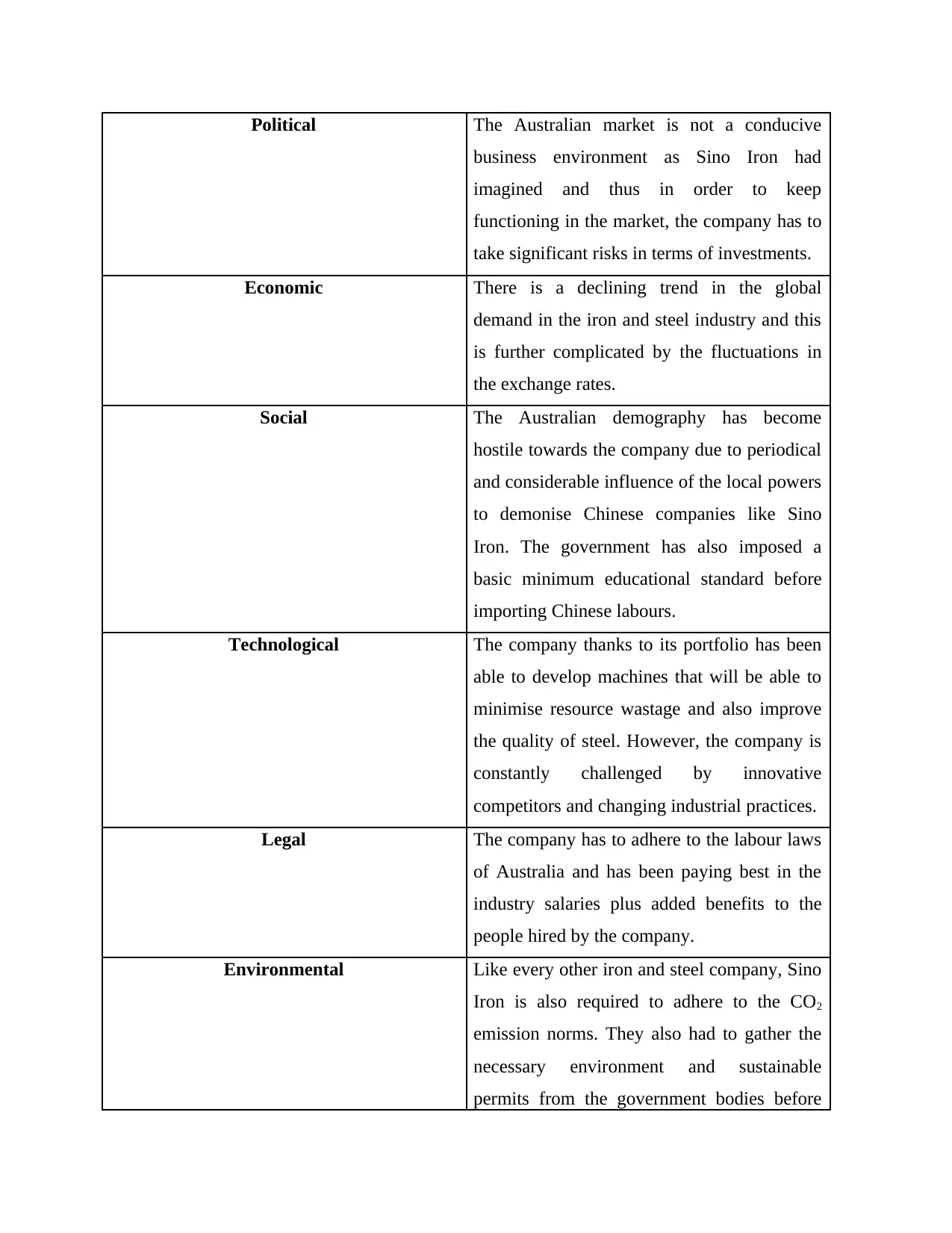
Political The Australian market is not a conducive
business environment as Sino Iron had
imagined and thus in order to keep
functioning in the market, the company has to
take significant risks in terms of investments.
Economic There is a declining trend in the global
demand in the iron and steel industry and this
is further complicated by the fluctuations in
the exchange rates.
Social The Australian demography has become
hostile towards the company due to periodical
and considerable influence of the local powers
to demonise Chinese companies like Sino
Iron. The government has also imposed a
basic minimum educational standard before
importing Chinese labours.
Technological The company thanks to its portfolio has been
able to develop machines that will be able to
minimise resource wastage and also improve
the quality of steel. However, the company is
constantly challenged by innovative
competitors and changing industrial practices.
Legal The company has to adhere to the labour laws
of Australia and has been paying best in the
industry salaries plus added benefits to the
people hired by the company.
Environmental Like every other iron and steel company, Sino
Iron is also required to adhere to the CO2
emission norms. They also had to gather the
necessary environment and sustainable
permits from the government bodies before
business environment as Sino Iron had
imagined and thus in order to keep
functioning in the market, the company has to
take significant risks in terms of investments.
Economic There is a declining trend in the global
demand in the iron and steel industry and this
is further complicated by the fluctuations in
the exchange rates.
Social The Australian demography has become
hostile towards the company due to periodical
and considerable influence of the local powers
to demonise Chinese companies like Sino
Iron. The government has also imposed a
basic minimum educational standard before
importing Chinese labours.
Technological The company thanks to its portfolio has been
able to develop machines that will be able to
minimise resource wastage and also improve
the quality of steel. However, the company is
constantly challenged by innovative
competitors and changing industrial practices.
Legal The company has to adhere to the labour laws
of Australia and has been paying best in the
industry salaries plus added benefits to the
people hired by the company.
Environmental Like every other iron and steel company, Sino
Iron is also required to adhere to the CO2
emission norms. They also had to gather the
necessary environment and sustainable
permits from the government bodies before
⊘ This is a preview!⊘
Do you want full access?
Subscribe today to unlock all pages.

Trusted by 1+ million students worldwide
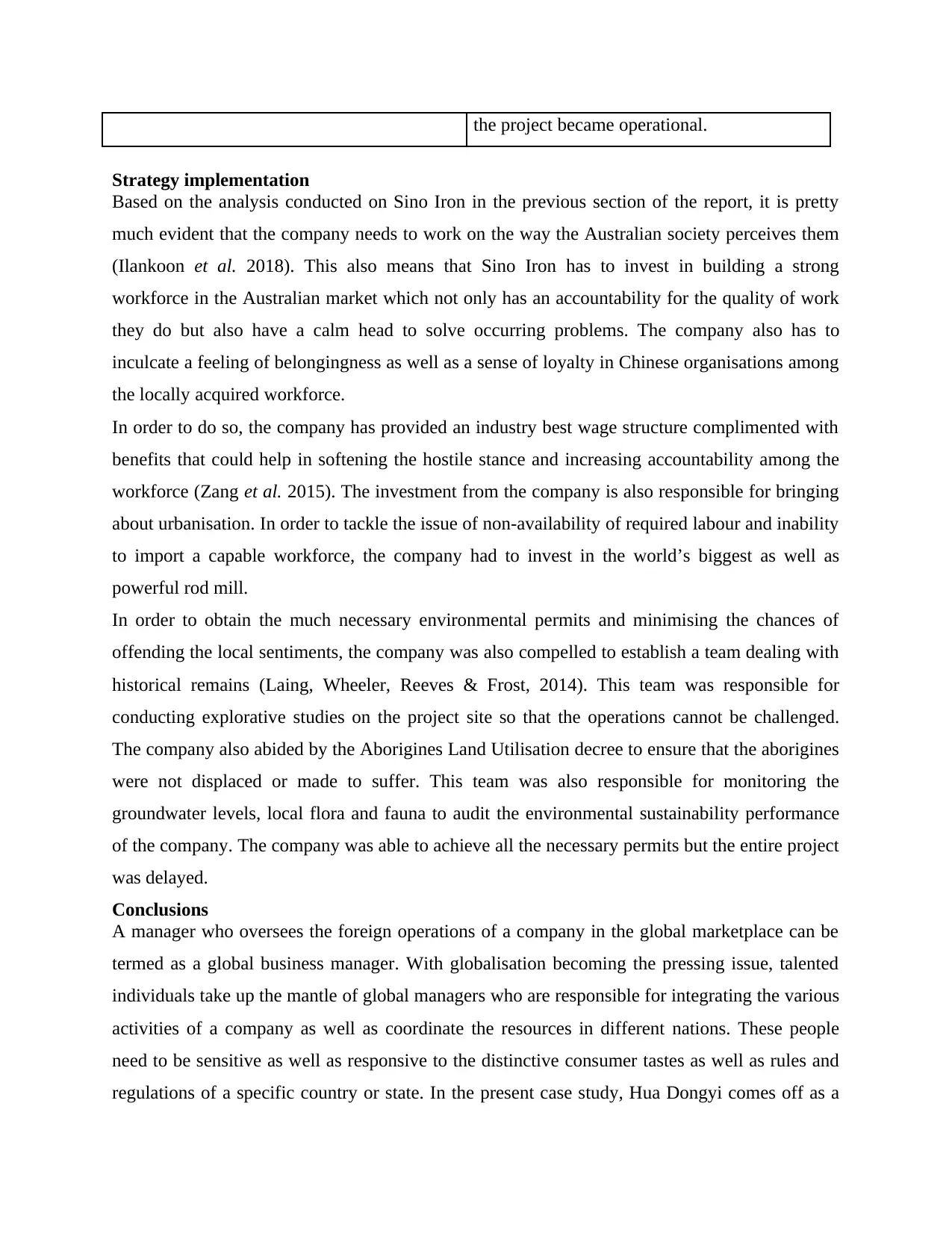
the project became operational.
Strategy implementation
Based on the analysis conducted on Sino Iron in the previous section of the report, it is pretty
much evident that the company needs to work on the way the Australian society perceives them
(Ilankoon et al. 2018). This also means that Sino Iron has to invest in building a strong
workforce in the Australian market which not only has an accountability for the quality of work
they do but also have a calm head to solve occurring problems. The company also has to
inculcate a feeling of belongingness as well as a sense of loyalty in Chinese organisations among
the locally acquired workforce.
In order to do so, the company has provided an industry best wage structure complimented with
benefits that could help in softening the hostile stance and increasing accountability among the
workforce (Zang et al. 2015). The investment from the company is also responsible for bringing
about urbanisation. In order to tackle the issue of non-availability of required labour and inability
to import a capable workforce, the company had to invest in the world’s biggest as well as
powerful rod mill.
In order to obtain the much necessary environmental permits and minimising the chances of
offending the local sentiments, the company was also compelled to establish a team dealing with
historical remains (Laing, Wheeler, Reeves & Frost, 2014). This team was responsible for
conducting explorative studies on the project site so that the operations cannot be challenged.
The company also abided by the Aborigines Land Utilisation decree to ensure that the aborigines
were not displaced or made to suffer. This team was also responsible for monitoring the
groundwater levels, local flora and fauna to audit the environmental sustainability performance
of the company. The company was able to achieve all the necessary permits but the entire project
was delayed.
Conclusions
A manager who oversees the foreign operations of a company in the global marketplace can be
termed as a global business manager. With globalisation becoming the pressing issue, talented
individuals take up the mantle of global managers who are responsible for integrating the various
activities of a company as well as coordinate the resources in different nations. These people
need to be sensitive as well as responsive to the distinctive consumer tastes as well as rules and
regulations of a specific country or state. In the present case study, Hua Dongyi comes off as a
Strategy implementation
Based on the analysis conducted on Sino Iron in the previous section of the report, it is pretty
much evident that the company needs to work on the way the Australian society perceives them
(Ilankoon et al. 2018). This also means that Sino Iron has to invest in building a strong
workforce in the Australian market which not only has an accountability for the quality of work
they do but also have a calm head to solve occurring problems. The company also has to
inculcate a feeling of belongingness as well as a sense of loyalty in Chinese organisations among
the locally acquired workforce.
In order to do so, the company has provided an industry best wage structure complimented with
benefits that could help in softening the hostile stance and increasing accountability among the
workforce (Zang et al. 2015). The investment from the company is also responsible for bringing
about urbanisation. In order to tackle the issue of non-availability of required labour and inability
to import a capable workforce, the company had to invest in the world’s biggest as well as
powerful rod mill.
In order to obtain the much necessary environmental permits and minimising the chances of
offending the local sentiments, the company was also compelled to establish a team dealing with
historical remains (Laing, Wheeler, Reeves & Frost, 2014). This team was responsible for
conducting explorative studies on the project site so that the operations cannot be challenged.
The company also abided by the Aborigines Land Utilisation decree to ensure that the aborigines
were not displaced or made to suffer. This team was also responsible for monitoring the
groundwater levels, local flora and fauna to audit the environmental sustainability performance
of the company. The company was able to achieve all the necessary permits but the entire project
was delayed.
Conclusions
A manager who oversees the foreign operations of a company in the global marketplace can be
termed as a global business manager. With globalisation becoming the pressing issue, talented
individuals take up the mantle of global managers who are responsible for integrating the various
activities of a company as well as coordinate the resources in different nations. These people
need to be sensitive as well as responsive to the distinctive consumer tastes as well as rules and
regulations of a specific country or state. In the present case study, Hua Dongyi comes off as a
Paraphrase This Document
Need a fresh take? Get an instant paraphrase of this document with our AI Paraphraser
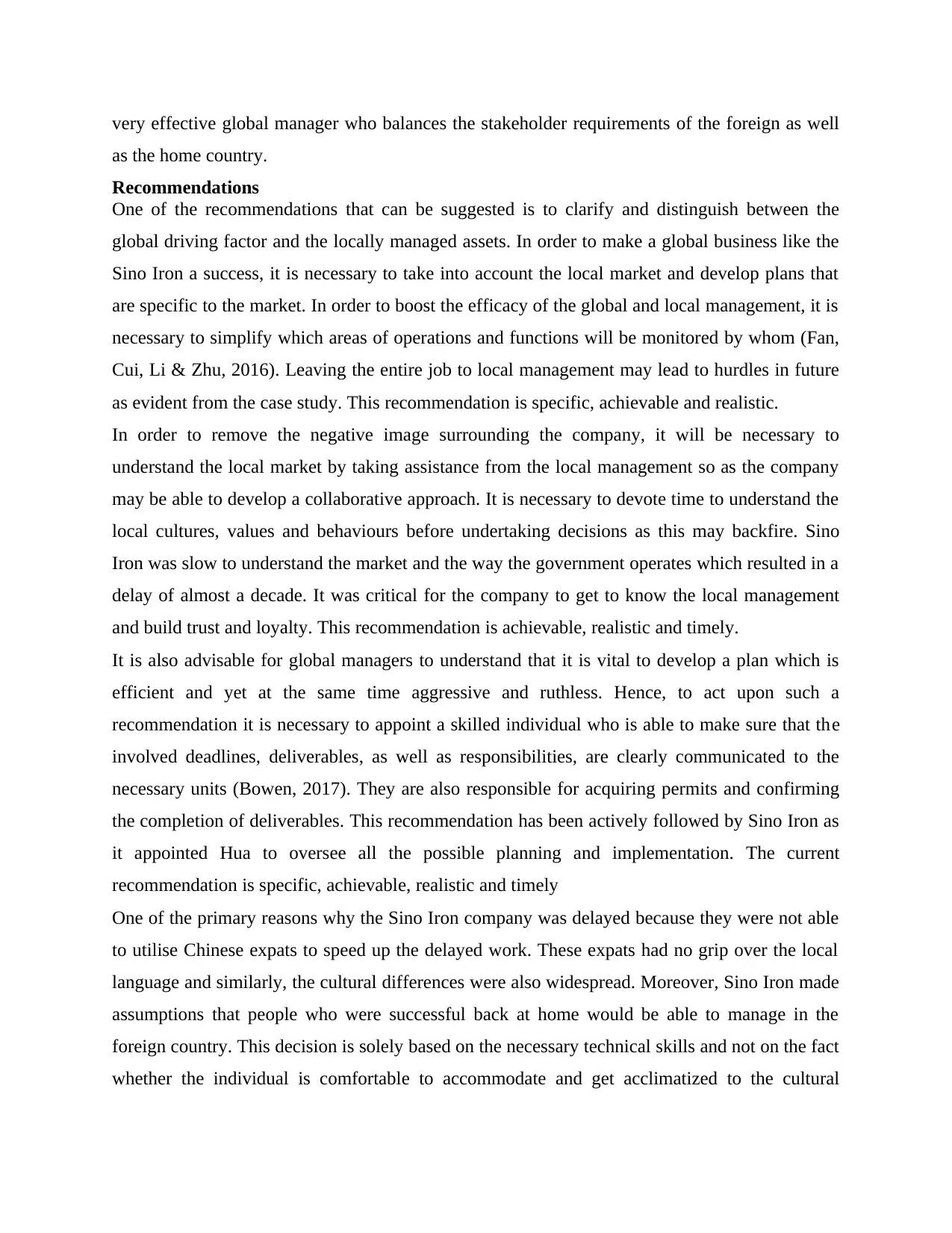
very effective global manager who balances the stakeholder requirements of the foreign as well
as the home country.
Recommendations
One of the recommendations that can be suggested is to clarify and distinguish between the
global driving factor and the locally managed assets. In order to make a global business like the
Sino Iron a success, it is necessary to take into account the local market and develop plans that
are specific to the market. In order to boost the efficacy of the global and local management, it is
necessary to simplify which areas of operations and functions will be monitored by whom (Fan,
Cui, Li & Zhu, 2016). Leaving the entire job to local management may lead to hurdles in future
as evident from the case study. This recommendation is specific, achievable and realistic.
In order to remove the negative image surrounding the company, it will be necessary to
understand the local market by taking assistance from the local management so as the company
may be able to develop a collaborative approach. It is necessary to devote time to understand the
local cultures, values and behaviours before undertaking decisions as this may backfire. Sino
Iron was slow to understand the market and the way the government operates which resulted in a
delay of almost a decade. It was critical for the company to get to know the local management
and build trust and loyalty. This recommendation is achievable, realistic and timely.
It is also advisable for global managers to understand that it is vital to develop a plan which is
efficient and yet at the same time aggressive and ruthless. Hence, to act upon such a
recommendation it is necessary to appoint a skilled individual who is able to make sure that the
involved deadlines, deliverables, as well as responsibilities, are clearly communicated to the
necessary units (Bowen, 2017). They are also responsible for acquiring permits and confirming
the completion of deliverables. This recommendation has been actively followed by Sino Iron as
it appointed Hua to oversee all the possible planning and implementation. The current
recommendation is specific, achievable, realistic and timely
One of the primary reasons why the Sino Iron company was delayed because they were not able
to utilise Chinese expats to speed up the delayed work. These expats had no grip over the local
language and similarly, the cultural differences were also widespread. Moreover, Sino Iron made
assumptions that people who were successful back at home would be able to manage in the
foreign country. This decision is solely based on the necessary technical skills and not on the fact
whether the individual is comfortable to accommodate and get acclimatized to the cultural
as the home country.
Recommendations
One of the recommendations that can be suggested is to clarify and distinguish between the
global driving factor and the locally managed assets. In order to make a global business like the
Sino Iron a success, it is necessary to take into account the local market and develop plans that
are specific to the market. In order to boost the efficacy of the global and local management, it is
necessary to simplify which areas of operations and functions will be monitored by whom (Fan,
Cui, Li & Zhu, 2016). Leaving the entire job to local management may lead to hurdles in future
as evident from the case study. This recommendation is specific, achievable and realistic.
In order to remove the negative image surrounding the company, it will be necessary to
understand the local market by taking assistance from the local management so as the company
may be able to develop a collaborative approach. It is necessary to devote time to understand the
local cultures, values and behaviours before undertaking decisions as this may backfire. Sino
Iron was slow to understand the market and the way the government operates which resulted in a
delay of almost a decade. It was critical for the company to get to know the local management
and build trust and loyalty. This recommendation is achievable, realistic and timely.
It is also advisable for global managers to understand that it is vital to develop a plan which is
efficient and yet at the same time aggressive and ruthless. Hence, to act upon such a
recommendation it is necessary to appoint a skilled individual who is able to make sure that the
involved deadlines, deliverables, as well as responsibilities, are clearly communicated to the
necessary units (Bowen, 2017). They are also responsible for acquiring permits and confirming
the completion of deliverables. This recommendation has been actively followed by Sino Iron as
it appointed Hua to oversee all the possible planning and implementation. The current
recommendation is specific, achievable, realistic and timely
One of the primary reasons why the Sino Iron company was delayed because they were not able
to utilise Chinese expats to speed up the delayed work. These expats had no grip over the local
language and similarly, the cultural differences were also widespread. Moreover, Sino Iron made
assumptions that people who were successful back at home would be able to manage in the
foreign country. This decision is solely based on the necessary technical skills and not on the fact
whether the individual is comfortable to accommodate and get acclimatized to the cultural

differences (Eriksen, 2018). If the company was willing to provide an opportunity to appropriate
individuals to develop leadership skills and knowledge transfer, there would have been fewer
complications.
individuals to develop leadership skills and knowledge transfer, there would have been fewer
complications.
⊘ This is a preview!⊘
Do you want full access?
Subscribe today to unlock all pages.

Trusted by 1+ million students worldwide
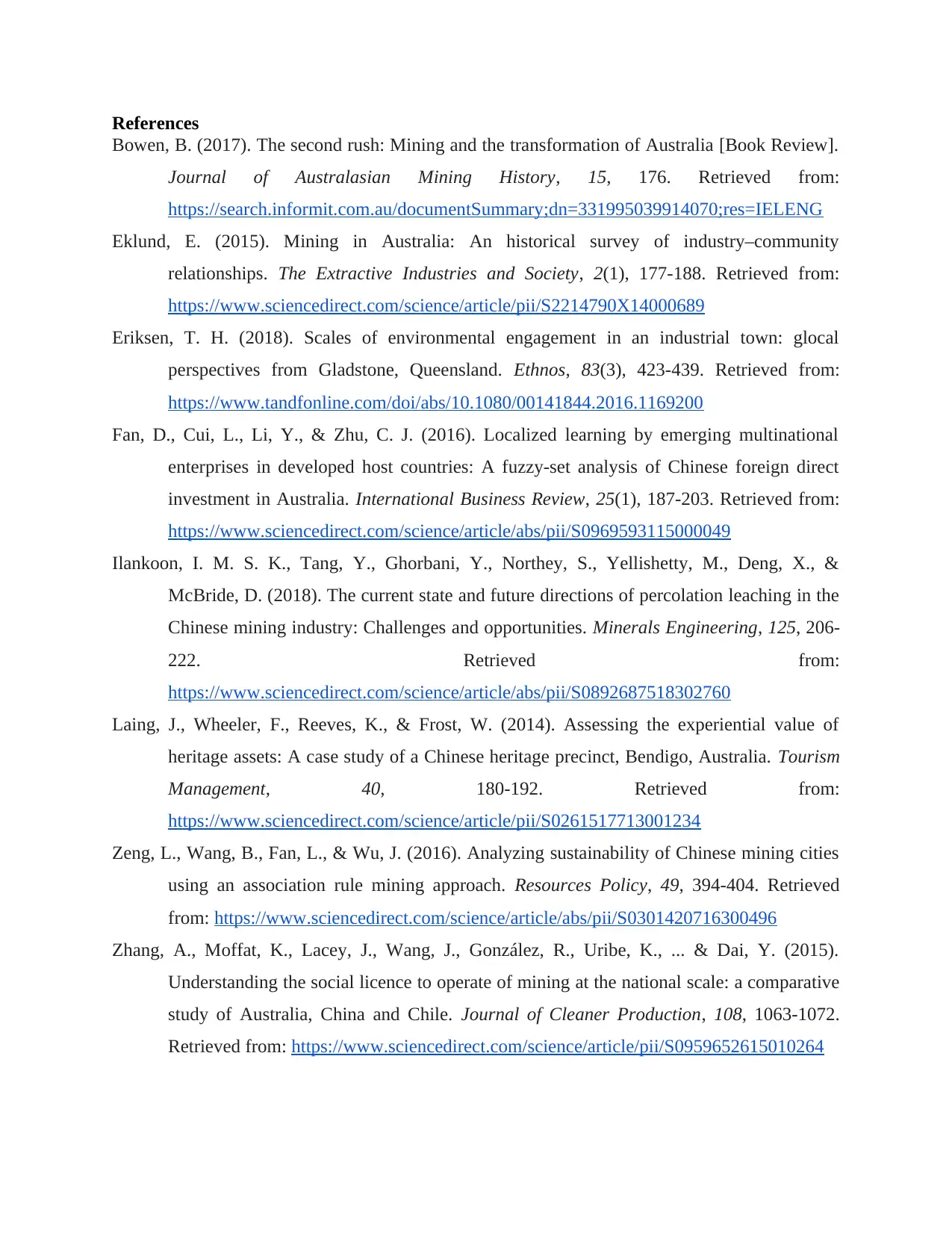
References
Bowen, B. (2017). The second rush: Mining and the transformation of Australia [Book Review].
Journal of Australasian Mining History, 15, 176. Retrieved from:
https://search.informit.com.au/documentSummary;dn=331995039914070;res=IELENG
Eklund, E. (2015). Mining in Australia: An historical survey of industry–community
relationships. The Extractive Industries and Society, 2(1), 177-188. Retrieved from:
https://www.sciencedirect.com/science/article/pii/S2214790X14000689
Eriksen, T. H. (2018). Scales of environmental engagement in an industrial town: glocal
perspectives from Gladstone, Queensland. Ethnos, 83(3), 423-439. Retrieved from:
https://www.tandfonline.com/doi/abs/10.1080/00141844.2016.1169200
Fan, D., Cui, L., Li, Y., & Zhu, C. J. (2016). Localized learning by emerging multinational
enterprises in developed host countries: A fuzzy-set analysis of Chinese foreign direct
investment in Australia. International Business Review, 25(1), 187-203. Retrieved from:
https://www.sciencedirect.com/science/article/abs/pii/S0969593115000049
Ilankoon, I. M. S. K., Tang, Y., Ghorbani, Y., Northey, S., Yellishetty, M., Deng, X., &
McBride, D. (2018). The current state and future directions of percolation leaching in the
Chinese mining industry: Challenges and opportunities. Minerals Engineering, 125, 206-
222. Retrieved from:
https://www.sciencedirect.com/science/article/abs/pii/S0892687518302760
Laing, J., Wheeler, F., Reeves, K., & Frost, W. (2014). Assessing the experiential value of
heritage assets: A case study of a Chinese heritage precinct, Bendigo, Australia. Tourism
Management, 40, 180-192. Retrieved from:
https://www.sciencedirect.com/science/article/pii/S0261517713001234
Zeng, L., Wang, B., Fan, L., & Wu, J. (2016). Analyzing sustainability of Chinese mining cities
using an association rule mining approach. Resources Policy, 49, 394-404. Retrieved
from: https://www.sciencedirect.com/science/article/abs/pii/S0301420716300496
Zhang, A., Moffat, K., Lacey, J., Wang, J., González, R., Uribe, K., ... & Dai, Y. (2015).
Understanding the social licence to operate of mining at the national scale: a comparative
study of Australia, China and Chile. Journal of Cleaner Production, 108, 1063-1072.
Retrieved from: https://www.sciencedirect.com/science/article/pii/S0959652615010264
Bowen, B. (2017). The second rush: Mining and the transformation of Australia [Book Review].
Journal of Australasian Mining History, 15, 176. Retrieved from:
https://search.informit.com.au/documentSummary;dn=331995039914070;res=IELENG
Eklund, E. (2015). Mining in Australia: An historical survey of industry–community
relationships. The Extractive Industries and Society, 2(1), 177-188. Retrieved from:
https://www.sciencedirect.com/science/article/pii/S2214790X14000689
Eriksen, T. H. (2018). Scales of environmental engagement in an industrial town: glocal
perspectives from Gladstone, Queensland. Ethnos, 83(3), 423-439. Retrieved from:
https://www.tandfonline.com/doi/abs/10.1080/00141844.2016.1169200
Fan, D., Cui, L., Li, Y., & Zhu, C. J. (2016). Localized learning by emerging multinational
enterprises in developed host countries: A fuzzy-set analysis of Chinese foreign direct
investment in Australia. International Business Review, 25(1), 187-203. Retrieved from:
https://www.sciencedirect.com/science/article/abs/pii/S0969593115000049
Ilankoon, I. M. S. K., Tang, Y., Ghorbani, Y., Northey, S., Yellishetty, M., Deng, X., &
McBride, D. (2018). The current state and future directions of percolation leaching in the
Chinese mining industry: Challenges and opportunities. Minerals Engineering, 125, 206-
222. Retrieved from:
https://www.sciencedirect.com/science/article/abs/pii/S0892687518302760
Laing, J., Wheeler, F., Reeves, K., & Frost, W. (2014). Assessing the experiential value of
heritage assets: A case study of a Chinese heritage precinct, Bendigo, Australia. Tourism
Management, 40, 180-192. Retrieved from:
https://www.sciencedirect.com/science/article/pii/S0261517713001234
Zeng, L., Wang, B., Fan, L., & Wu, J. (2016). Analyzing sustainability of Chinese mining cities
using an association rule mining approach. Resources Policy, 49, 394-404. Retrieved
from: https://www.sciencedirect.com/science/article/abs/pii/S0301420716300496
Zhang, A., Moffat, K., Lacey, J., Wang, J., González, R., Uribe, K., ... & Dai, Y. (2015).
Understanding the social licence to operate of mining at the national scale: a comparative
study of Australia, China and Chile. Journal of Cleaner Production, 108, 1063-1072.
Retrieved from: https://www.sciencedirect.com/science/article/pii/S0959652615010264
1 out of 10
Related Documents
Your All-in-One AI-Powered Toolkit for Academic Success.
+13062052269
info@desklib.com
Available 24*7 on WhatsApp / Email
![[object Object]](/_next/static/media/star-bottom.7253800d.svg)
Unlock your academic potential
Copyright © 2020–2025 A2Z Services. All Rights Reserved. Developed and managed by ZUCOL.





